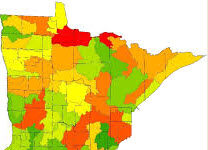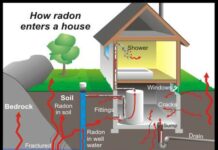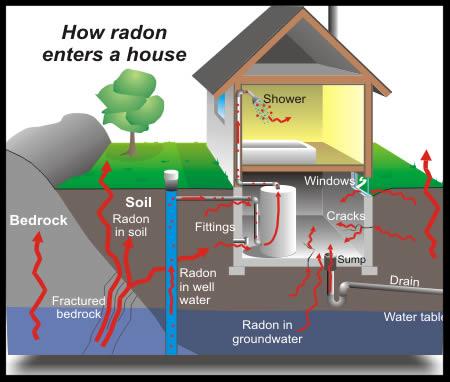Radon is a naturally occurring radioactive gas.
It’s produced when uranium, thorium, and radium break down in soil, rock, and water. It’s then released into the air. Radon is odorless, tasteless, and invisible.
Radon can accumulate in some places where ventilation is inadequate, such as in an underground mine. It can also build up inside buildings. Long-term exposure to high levels of radon can be dangerous to your health.
Continue reading to learn where you’re likely to find high levels of radon, how to test for it, and how it can impact your health.
You’re exposed to radon when you breathe it in. High amounts of radon may be found in the workplace, a school, or any building. You spend the most time in your home, so that’s where radon exposure is most likely.
Radon can come up through the ground and into your home through cracks in the foundation. Once it’s through the cracks, it can get trapped inside, where it builds up. It can also get into your home through well water. Rarely, building materials have been found to release radon into buildings.
Radon exposure can happen in any type of home, whether it has a basement, a crawl space, or is built on a slab. But it’s more likely to accumulate in homes that are:
- very well insulated
- tightly sealed
- located where the soil contains a lot of uranium, thorium, and radium
About one in every 15 homes is thought to have high levels of radon. The highest concentration of radon tends to be found in the basement or on the first floor.
How to test your home for radon
It’s not enough to know that the house next door has been tested, because radon levels can vary from one building to the next. The only way to know for sure if you have too much radon in your home is to test for it. You can do this on your own without the help of a professional.
Short-term testing
If you’re in a hurry, you can use a short-term test. Some of these tests measure radon for just 2 or 3 days, while others measure up to 90 days. For a short-term test, you’ll need to keep your windows and doors closed as much as possible and avoid fans that bring in air from the outside.
Short-term devices include:
- alpha-track detectors
- charcoal canisters
- charcoal liquid scintillation detectors
- electret ion chambers
- continuous monitors
Long-term testing
Radon levels fluctuate day to day and month to month, so you’ll get the most accurate results from a long-term test. These tests measure radon levels for more than 90 days. Alpha-track and electret ion chamber detectors are usually used for long-term testing.
Either way, the tests are fairly inexpensive and simple to use. You can pick one up at most hardware stores. For accurate results, it’s important to follow package instructions carefully. Test kits should be placed in the basement or lowest level of the home. Once you have the device in place, there’s nothing else you need to do.
When the test is complete, it’s simply a matter of packing it up as instructed and sending it back for analysis. You should have your results within a few weeks.
What to do if your home has high levels
A radon level of 4 picoCuries per liter (pCi/L) or more is considered high.
Most of the time, you can reduce radon without making major home renovations or spending a fortune.
You can
- Seal and caulk foundation cracks and openings to help reduce the amount of radon that can enter.
- Install a soil suction radon reduction system, also known as vent pipe and fan system. A three- or four-inch pipe pulls radon from underneath the house and vents it outside. This keeps it from accumulating inside your home.
- Create a gas-permeable layer beneath the slab or flooring. This allows radon to move under your house, but it only works if you have a basement or slab foundation. It’s not for homes with a crawl space.
- Install plastic sheeting. The sheeting goes on top of the gas-permeable layer under the slab to prevent radon from entering your home. If you have a crawl space, the sheeting goes over the crawl space floor.
The Environmental Protection Agency provides detailed information on how to reduce radon in your home, as well as how to find a qualified contractor to do the work.
If your radon levels aren’t 4 pCi/L or greater, but come close, it may be worth considering some of these remedies anyway.
What are the symptoms of radon poisoning?
Radon is all around us. In fact, you’re probably breathing it in every day, even if it’s at a low level. However, you can’t tell if you’re breathing it in at a high level. The danger in radon exposure is that you can’t see it, taste it, or smell it. And you won’t have any symptoms to alert you.
Is it true that radon poisoning can give you cancer?
Radon gas can damage cells in your lungs, which can lead to cancer. Radon is responsible for about 21,000 lung cancer deaths each year in the United States, though it usually takes 5 to 25 years to develop.
Early signs and symptoms of lung cancer may include:
- persistent cough
- coughing up blood
- wheezing
- shortness of breath
- hoarseness
- chest pain, especially when you cough or laugh
- frequent infections such as bronchitis and pneumonia
Over time, you may also experience loss of appetite, weight loss, and fatigue.
According to the American Cancer SocietyTrusted Source, smoking is the number one cause of lung cancer. Radon comes in second. About 10 percent of radon-related cancer deaths involve people who don’t smoke. People who do smoke and are exposed to high levels of radon are at even greater risk.
It’s estimated that lowering radon levels below 4 pCi/L could reduce lung cancer deaths by 2 to 4 percentTrusted Source, which could save about 5,000 lives.
What to do if you have symptoms
There aren’t any specific medical tests that can assess your exposure to radon gas. That’s why it’s important to be aware of the signs and symptoms of lung cancer, even if you don’t smoke.
See your doctor if you have a persistent cough, cough up blood, or have chest pain. Lung cancer is easier to treat in the earliest stages, before it has a chance to spread.
Radon is part of the environment and generally isn’t harmful. But long-term exposure to high levels of radon can put you at risk of developing lung cancer, especially if you smoke.
Testing for radon is fairly inexpensive and easy to do, so don’t hesitate to get started. And if you do find that there’s too much radon in your home, there are known remedies to make your home a safer place.
David Majkrzak

















